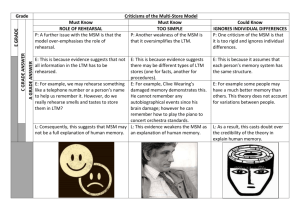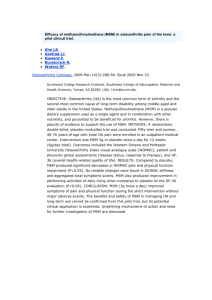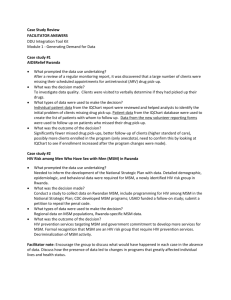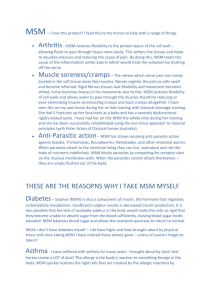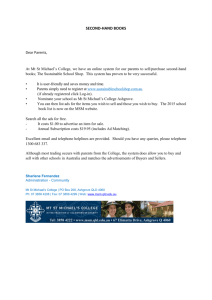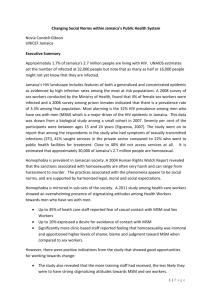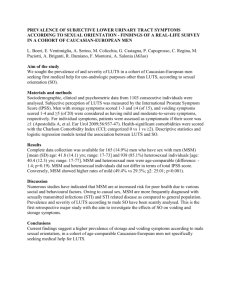ABSTRACT: 2015 ELAM Institutional Action Project Poster Symposium Project Title:
advertisement
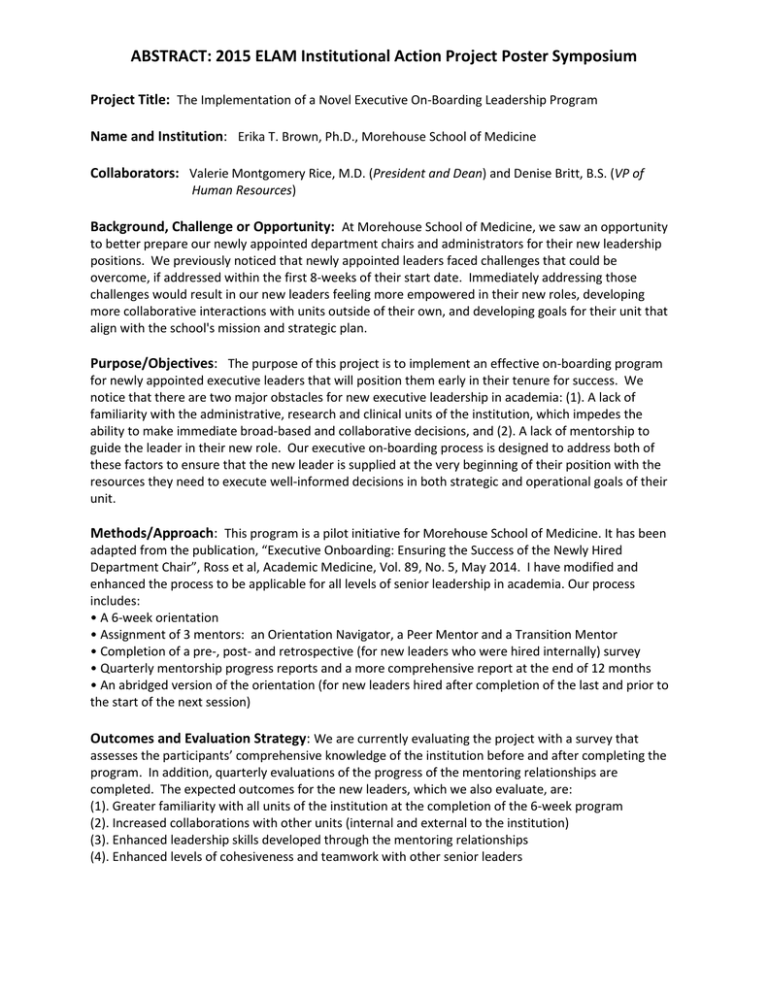
ABSTRACT: 2015 ELAM Institutional Action Project Poster Symposium Project Title: The Implementation of a Novel Executive On-Boarding Leadership Program Name and Institution: Erika T. Brown, Ph.D., Morehouse School of Medicine Collaborators: Valerie Montgomery Rice, M.D. (President and Dean) and Denise Britt, B.S. (VP of Human Resources) Background, Challenge or Opportunity: At Morehouse School of Medicine, we saw an opportunity to better prepare our newly appointed department chairs and administrators for their new leadership positions. We previously noticed that newly appointed leaders faced challenges that could be overcome, if addressed within the first 8-weeks of their start date. Immediately addressing those challenges would result in our new leaders feeling more empowered in their new roles, developing more collaborative interactions with units outside of their own, and developing goals for their unit that align with the school's mission and strategic plan. Purpose/Objectives: The purpose of this project is to implement an effective on-boarding program for newly appointed executive leaders that will position them early in their tenure for success. We notice that there are two major obstacles for new executive leadership in academia: (1). A lack of familiarity with the administrative, research and clinical units of the institution, which impedes the ability to make immediate broad-based and collaborative decisions, and (2). A lack of mentorship to guide the leader in their new role. Our executive on-boarding process is designed to address both of these factors to ensure that the new leader is supplied at the very beginning of their position with the resources they need to execute well-informed decisions in both strategic and operational goals of their unit. Methods/Approach: This program is a pilot initiative for Morehouse School of Medicine. It has been adapted from the publication, “Executive Onboarding: Ensuring the Success of the Newly Hired Department Chair”, Ross et al, Academic Medicine, Vol. 89, No. 5, May 2014. I have modified and enhanced the process to be applicable for all levels of senior leadership in academia. Our process includes: • A 6-week orientation • Assignment of 3 mentors: an Orientation Navigator, a Peer Mentor and a Transition Mentor • Completion of a pre-, post- and retrospective (for new leaders who were hired internally) survey • Quarterly mentorship progress reports and a more comprehensive report at the end of 12 months • An abridged version of the orientation (for new leaders hired after completion of the last and prior to the start of the next session) Outcomes and Evaluation Strategy: We are currently evaluating the project with a survey that assesses the participants’ comprehensive knowledge of the institution before and after completing the program. In addition, quarterly evaluations of the progress of the mentoring relationships are completed. The expected outcomes for the new leaders, which we also evaluate, are: (1). Greater familiarity with all units of the institution at the completion of the 6-week program (2). Increased collaborations with other units (internal and external to the institution) (3). Enhanced leadership skills developed through the mentoring relationships (4). Enhanced levels of cohesiveness and teamwork with other senior leaders The Implementation of a Novel Executive On-Boarding Leadership Program Erika T. Brown, Ph.D., Valerie Montgomery Rice, M.D., and Denise Britt, B.S. Morehouse School of Medicine, Atlanta, GA Methods/Outcomes/Evaluation Strategy Background /Opportunity At Morehouse School of Medicine, we saw an opportunity to better prepare our newly appointed department chairs and administrators for their new leadership positions. We previously noticed that newly appointed leaders faced challenges that could be overcome, if addressed within the first 8-weeks of their start date. Immediately addressing those challenges would result in our new leaders feeling more empowered in their new roles, developing more collaborative interactions with units outside of their own, and developing goals for their unit that align with the school's mission and strategic plan. 2. Assignment of three mentors 1. Create the curriculum Orientation Topic Facilitator(s) Introduction and Welcome to MSM (Reception with Mentors) Mentee/Participant Denise Britt Annemarie Eades Sheila Burks Desiree Ramirez John Case, Katherine Napier and Taya Scott The purpose of this project is to implement an effective onboarding program for newly appointed executive leaders that will position them early in their tenure for success. We notice that there are two major obstacles for new executive leadership in academia: (1). A lack of familiarity with the administrative, research and clinical units of the institution, which impedes the ability to make immediate broad-based and collaborative decisions, and (2). A lack of mentorship to guide the leader in their new role. Our executive on-boarding process is designed to address both of these factors to ensure that the new leader is supplied at the very beginning of their position with the resources they need to execute well-informed decisions in both strategic and operational goals of their unit. Approach This program is a pilot initiative for Morehouse School of Medicine. It has been adapted from the publications, “Executive Onboarding: Ensuring the Success of the Newly Hired Department Chair”, Ross et al, Academic Medicine, Vol. 89, No. 5, May 2014 and “Accelerating Leaders’ Transitions: A New Approach to Executive Onboarding”, A. Massaro, The Ohio State University, http://www.opm.gov/WIKI/uploads/docs/Wiki/ OPM/training/Accelerating-Leaders-Transitions.pdf. I have modified and enhanced the process to be applicable for all levels of senior leadership in academia. Our process includes: • A 6-week orientation • Assignment of 3 mentors: an Orientation Navigator, a Peer Mentor and a Transition Mentor • Completion of a pre-, post- and retrospective (for new leaders who were hired internally) survey • Quarterly mentorship progress reports and a more comprehensive report at the end of 12 months • An abridged version of the orientation (for new leaders hired after completion of the last and prior to the start of the next session) Dr. John Case Orientation Navigator Ms. Taya Scott Ms. Kathy Bremer (Boardwalk Consulting) kathy@boardwalkconsulting.com Dr. David Satcher Ms. Andrea Fox Dr. John Prescott (Association of American Medical Colleges) jprescott@aamc.org Dr. Janice Herbert-Carter Chair, Department of Medical Education Dr. Yolanda Wimberly Dr. Beverly Taylor Ms. Nakisha Hall Dr. Marsha Rappley (Michigan State University) rappley@msu.edu Joe Chevalier and Michael Flood Marketing & Communications and Institutional Advancement Academic Affairs Degree Programs Student Life Graduate Medical Education Martha Elks, Douglas Paulsen and Stephanie MilesRichardson Ngozi Anachebe and Deborah Lyn Yolanda Wimberly Erika Brown Faculty Affairs Life outside of MSM Dr. Herman Taylor Director, Cardiovascular Research Institute Dr. Peter MacLeish Mr. Patrick Thomas Dr. Robert Taylor (Emory University) w.robert.taylor@emory.edu Dr. Winston Thompson Chair, Department of Physiology Dr. Harry Strothers Mr. Patrick Thomas Ms. Lesia Waker Dr. Gerald Schatten (University of Pittsburgh/Magee-Women’s Research Institute) gschatten@mwri.magee.edu Dr. Yasmin Tyler-Hill Chair, Department of Pediatrics Dr. Gail Mattox Mr. Gary Lindsay Mr. Derrick Anderson Dr. Lawrence Wineski Chair, Department of Pathology Dr. Derrick Beech Ms. Renarder Pressley Dr. Barbara Stoll (Emory University) bstoll@emory.edu Dr. Patricia Thomas (University of Kansas Medical Center) PTHOMAS@kumc.edu Various members of the MSM community Clinical Affairs and MHC Research Affairs Tour of MSM Overall MSM Administration and Orientation Wrap-Up Derrick Beech and Michelle Nichols Sandra Harris-Hooker Neremiah Emmett President and Dean Valerie Montgomery Rice (via Skype, if not in person) and David Hefner B. External hires I have established collaborative relationships with other units/offices/departments on campus that will help in accomplishing my short-term and longterm goals for my unit/office/department. I am familiar with the employee resources available (i.e. HR, public safety, IT, compliance), and their respective contact people at MSM. I am familiar with the employee resources available (i.e. HR, public safety, IT, compliance), and their respective contact people at MSM. I am familiar with the employee resources available (i.e. HR, public safety, IT, compliance), and their respective contact people at MSM. I understand my role and responsibilities at MSM in my new position and how it is tied to the MSM enterprise. I understand my role and responsibilities Pre at MSM in my new position and how it is tied to the MSM Post enterprise. I understand my role and responsibilities at MSM Pre3 in my new position and how it is tied to the MSM enterprise. Post3 Pre2 I understand the mission of MSM and how employees are expected to promote the mission. I understand the mission of MSM and how employees are expected to promote the mission. I understand the mission of MSM and how employees are expected to promote the mission. I am familiar with the overall administrative structures of MSM and their functions. I am familiar with the overall administrative structures of MSM and their functions. I am familiar with the overall administrative structures of MSM and their functions. 1 2 3 4 5 0 1 2 3 • For new people, perhaps some orientation to life outside of the work place would be helpful. • I felt my questions were addressed, so I have nothing in particular to add here. Please provide any recommendations that you may have for improvement of the program. • It should be longer • Same length for each session—2 hours, but more time for each unit’s presentation, so therefore more sessions – maybe 8 weeks instead of six. 4 5 Future Directions Post2 Retrospective 0 Please provide comments about the program that you feel are important to know that have not been addressed. We completed our first cohort in October 2014 and started our second cohort in February 2015. To assess the effectiveness of the program, in addition to the pre-, post- and retrospective surveys and quarterly evaluations of the progress of the mentoring relationships, we also evaluate the following expected outcomes for the new leaders: (1) Greater familiarity with all units of the institution at the completion of the 6-week program, (2) Increased collaborations with other units (internal and external to the institution) , (3) Enhanced leadership skills developed through the mentoring relationships, and (4) Enhanced levels of cohesiveness and teamwork with other senior leaders. In addition, we are currently preparing a manuscript for submission that documents the program. C. Both internal and external I have established collaborative relationships with other units/offices/departments on campus that will help in accomplishing my short-term and long-term goals for my unit/office/department. I have established collaborative relationships with other units/offices/departments on campus that will help in accomplishing my short-term and long-term goals for my unit/office/department. • Excellent—I think it is an indispensible exercise. • Generally a positive experience in which all involved were focused on providing information needed to manage a department. • I’ve onboard at a couple institutions before. This is the most comprehensive and engaging onboarding I’ve every experienced. It was exceptional. Discussion/Conclusions 3. Administer pre-, post- and retrospective survey to assess effectiveness of on-boarding program A. MSM Internal hires Please describe your overall on-boarding experience. Ms. Ann Curry (Coxe Curry and Associates) ACurry@coxecurry.com Chief of Staff and Vice-President, Strategic Planning Institutional Operations: Public Safety and Facilities • High energy environment; strong desire for collaborative work. • Information about the clinical services function of the institution • Working collaboratively with my transition mentors and with my mentors from the community and having someone to bounce tactical and strategic perspectives off as I immerse myself into the institution. Transition Mentor Dr. David Hefner Bennie Harris and Ronna Nu’Man Purpose/Objectives Peer Mentor Sample Responses Please describe the most important thing(s) that you learned during the onboarding process. Assigned Mentor Position Name Dr. Bennie Harris Sr. Vice-President, Institutional Advancement and Marketing & Communications President and Dean Valerie Montgomery Rice (via Skype, if not in person) Sandra Harris-Hooker History of MSM Administrative Affairs Human Resources IT Legal Compliance Finance Question 0 1 2 3 *7 participants; 4 MSM, 3 New; 5-point Likert (1-strongly disagree, 5-strongly agree) 4. Celebrating the completion of the pilot of the MSM New Leadership Executive On-Boarding Program!!! 4 5 As a result of the overwhelming interest in participation from veteran MSM employees, the on-boarding program has successfully laid the foundation for the development of a Leadership Academy that will include the following: (1) Addition of leadership enhancement courses to the curriculum, (2) Development of a competitive application process that will admit 6-8 MSM employees per year, (3) Participants form groups to work on a project similar to an IAP, (4) Allowance of participation in selected modules, non-competitively, if full participation in the Leadership Academy is not possible, and (5) An institutional certification at completion. Our “found pilot” is the Woodruff Leadership Academy (WLA) at Emory University. It was established in 2002 and has received national recognition. I have partnered with the WLA directors for guidance in executing our program at MSM. Our on-boarding program has been phenomenal; therefore, I have immense expectations for the Leadership Academy to continue to transform MSM. Presented at the 2015 ELAM ® Leaders Forum
